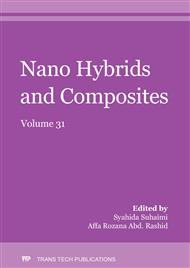p.1
p.7
p.17
p.25
p.35
p.45
p.55
p.65
p.73
The Synthesis and Characterization of Anodic Alumina Oxide Using Sulfuric Acid and Oxalic Acid
Abstract:
Anodic Alumina Oxide (AAO) is one of the nanomaterials that have developed as a template in the nanowires, nanodots and nanotubes. This research focuses on synthesizing AAO by two different electrolytic solutions which are using sulfuric acid (H2SO4) and oxalic acid (C2H2O4) by electrochemical anodization method. Two parameters were influencing the anodization process in the experiment; the type and the concentration of the electrolytic solution. The effects of the different type of electrolytic solutions produced different size of pores. When the voltage used is 25 V in H2SO4, the optimum reading size of the nanopores is in the range of 16-22 nm, whereas the AAO pores in C2H2O4 are in the range of 100-200 nm. Meanwhile, the concentration of H2SO4 and C2H2O4 is set to be 0.3 M, 0.4 M and 0.5 M., The results in 0.3 M H2SO4 and C2H2O4, show the optimum concentration of electrolytic solutions which is the key parameter affecting the morphological structure of porous membranes in AAO. The optimum value for these two acidic solutions has produced such highly ordered arrangement of nanopores which are from the average size of nanopores that anodized in sulfuric acid is 19 nm while 120 nm in oxalic acid. The morphological structure properties of AAO templates include the diameter of nanopores, the thickness of membrane and density of nanopores would be examined by Field Emission Scanning Electron Microscope (FESEM) and Energy Dispersive X-ray (EDX). Also, Fourier-transmittance infrared spectroscopy (FTIR) detected the chemical functional group of bonds in AAO. In conclusion, AAO templates have a big potential to be the major contributor in the future for the development of new electronic devices.
Info:
Periodical:
Pages:
35-44
Citation:
Online since:
February 2021
Keywords:
Price:
Сopyright:
© 2021 Trans Tech Publications Ltd. All Rights Reserved
Share:
Citation:


